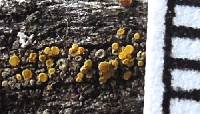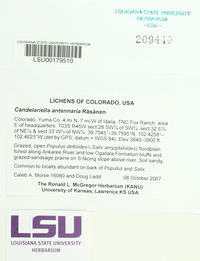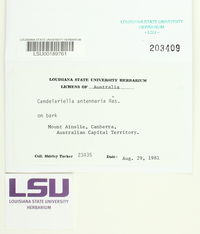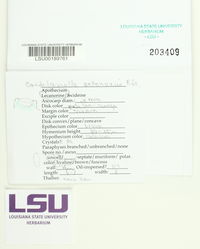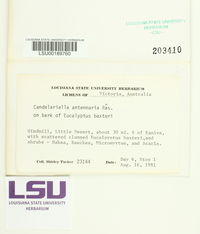
Consortium of Lichen Herbaria
- building a Global Consortium of Bryophytes and Lichens as keystones of cryptobiotic communities -
- Home
- Search
- Images
- Species Checklists
- US States: O-Z >
- US National Parks
- Central America
- South America
- US National Parks
- Southern Subpolar Region
|
|
|
|
Family: Candelariaceae
|
Nash, T.H., Ryan, B.D., Gries, C., Bungartz, F., (eds.) 2004. Lichen Flora of the Greater Sonoran Desert Region. Vol 2. Thallus: variable, indistinct or a thin to thick amorphous crust to thick and ±continuous, sometimes granular surface: pale to dark gray to brownish gray to green-gray cortex: pseudoparenchymatous, 5-10 µm thick Apothecia: abundant, lecanorine, 0.25-0.7 mm wide disc: yellow, round, ±flat margin: thin to thick, persistent, yellow but outer part often gray especially in young apothecia, smooth or appearing somewhat "hairy" exciple: thin, not visible from the outside epihymenium: yellow-brown hymenium: hyaline, 55-80 µm tall; paraphyses: frequently branched near the apices, mostly club-shaped to submoniliform with up to 7 µm wide tips; hypothecium: hyaline asci: clavate, 8-spored ascospores: hyaline, simple to 1septate, oblong to narrowly ellipsoid, 11-17 x 5-6.5 µm Pycnidia: rare, appearing as yellow spots on the thallus conidia: hyaline, oblong to ellipsoid, 2.5-3 x 1.2-1.5 µm Spot tests: disc K- to K+ reddish, KC-, C- Secondary metabolites: in yellow parts, calycin, pulvinic acid, pulvinic dilactone and vulpinic acid. Substrate and ecology: on the bark of broad-leaved trees or on wood World distribution: North and South America, Asia, and Australia Sonoran distribution: on a wide variety of trees and shrubs in desert-grassland transitions, juniper chaparral, pinyon pine-juniper woodland and mixed pine forests in Arizona and California up to at least 2300 m. Notes: Candelariella antennaria is a common species with a rather variable thallus appearance. It is characterized by the lack of a yellow thallus and its club-shaped to submoniliform paraphyses, which are frequently branched near the apices. Usually the name C. deflexa, which is a synonym to C. aurella, has been used for this taxon in North America. |
Powered by Symbiota



